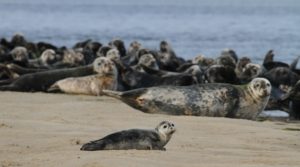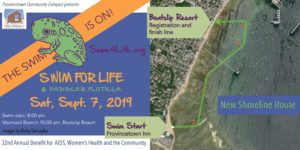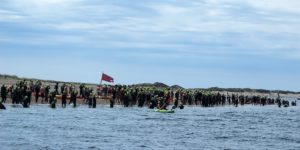PROVINCETOWN — Calls to curb the seal population in Cape Cod waters by ending their protected status under federal law are misguided, say scientists who study marine ecology. In spite of the increased presence of great white sharks here, they say, the return of both seals and sharks represents a re-establishment of the balance of nature that was upset by decades of seal hunting.
Moreover, seals are wrongly blamed for polluting the water with their feces, and their effect on fish populations has been exaggerated, according to experts in marine life.

Citizen groups like the Nantucket-based Seal Action Committee are calling for the removal of seals from the federal Marine Mammal Protection Act. The Barnstable County Commissioners heard a presentation from that group last month, and Commissioner Ron Beaty has argued that seals are a threat to the regional tourist economy. The evidence on the economy suggests otherwise.
Richard Delaney, president of the Provincetown Center for Coastal Studies (CCS), says the seal population will eventually stabilize once it reaches its carrying capacity in the Cape’s waters. Disease, predation from sharks, and limited food availability will “re-establish the balance that we really knocked out of kilter when we decided to interfere with it,” he said.
Before 1800, seals inhabited the Cape in large numbers. “This was a natural habitat for them for years, until people decided that they were a nuisance,” Delaney said.
From the late 1800s through the early 1960s, the state maintained a bounty on seals. “If you were a citizen of Cape Cod and killed a seal and brought its nose to town hall, you’d get a payment,” Delaney said. “That bounty put on seals basically eliminated all the seals in this area.”
In 1972 Congress passed the Marine Mammal Protection Act, which prohibited killing seals and whales. “Once they were protected, seals were able to re-establish their natural niche in the ecosystem,” Delaney said. “That’s why from 1972 to now we have seen an increase in the population.”
Responding to the shark threat
The risk of shark attack, though small, is real. Rather than killing sharks or seals, however, marine scientists advocate more caution in the water. One example of that approach is a change of course for Provincetown’s popular annual Swim for Life, scheduled for Sept. 7 this year.
Instead of crossing the open water of Provincetown Harbor from Long Point to the Boatslip Resort, as swimmers have done for each of the past 31 years, participants will instead swim along the coast.

Swim for Life organizers decided to change the route two weeks ago, when the Cape Cod National Seashore denied a permit for the usual course because of concerns about shark activity.
“It’s a low risk, but if something were to happen it would be a major catastrophe,” said Jay Critchley, director of the Provincetown Community Compact, which has sponsored the swim since its inception. Compact directors have discussed the possibility of alternate routes for several years as shark activity has increased, Critchley said.
“The Compact board and Park Service were on the same page this year” about changing course, he said. This year, the swim will begin at the Provincetown Inn and finish, as usual, at the Boatslip.
Critchley hopes the coastal route will mitigate fear among participants. “Every time I talk with somebody about the Swim for Life, they bring up Jaws,” he said. “That movie really scared people about being in nature.”
Intense media coverage of the two shark attacks last summer in Truro and Wellfleet did not help. “The heightened public awareness and public concern about sharks, plus a lot of video — it’s just been an extravaganza,” he said.
The evidence on seals and culling
Andrea Bogomolni, chair of the Northeast Atlantic Seal Research Consortium, confirmed that the large seal population has both increased shark activity and caused some fish-stealing. As fish struggle against lines, they tire out, making them an easy dinner for seals.
“Much of the recreational catch is thrown overboard [after being caught], so the discarded fish also attracts seals,” Bogomolni said.
Provincetown charter boat Capt. Mike Rathgeber is concerned about the seals’ effect on Cape Cod’s ecosystems. But the seals have not been bad for business. In fact, Rathgeber said, “I’ve been using seals as a fish finder.” Seals hauled out on a beach typically indicate a large supply of fish in the surrounding waters.
The recreational anglers that Rathgeber hosts also enjoy a “seal show” as the animals swarm around the boat to devour scraps left over from filleting.
For all their cuteness, seals can be a nuisance, often eating the fish off Rathgeber’s lines. When a seal starts its attack on the hooked fish, “the only recourse we have is to cut the line and give it to them, but it also means the seal is eating the hook,” he said. “It happens very frequently, almost on a daily basis.”
But market fish are not the seals’ primary source of food, according to preliminary results from a CCS research study. Delaney said seals primarily eat sand lances, small fish of about four or five inches, which are not fished for human consumption.
“Seals actually eat an awful lot of things other than the striped bass and bluefish that the fishermen complain about,” Delaney said.
Furthermore, seals do not contribute to water pollution. Delaney said that rigorous studies have not been able to prove a correlation between pollution and the presence of seals.
“We human beings are far more culpable for putting pollution into the ocean than seals could ever be,” he said.
Moreover, any effort to cull seals would be unlikely to have much effect. Even if all the seals in Cape Cod waters were exterminated, more would come to replace them. Delaney said that the 450,000 seals currently living in Nova Scotia would quickly fill the gap.
“Once some of the seals realized it was safe, they could expand their habitat back down here,” he said. “The whole idea of culling seals is not based in science and does not understand the ecological relationships seals have in the ocean.” Seals play important roles in the coastal ecosystem, and their large numbers are a sign of a healthy environment.
Climate change is not to blame for the booming seal population, at least not directly, Bogomolni said. Although some species, like lobster, are migrating farther north to find cooler water, the seals’ diverse diet allows them greater flexibility in habitat.
Adapting to a changing environment
The increase in the seal population has undoubtedly caused some growing pains, but adapting to evolving environmental conditions also creates new possibilities for communities on the Outer Cape.
For example, the Swim for Life’s new course may make the event more accessible. With less risk of shark attack, “We’re hoping that there will actually be more swimmers this year,” Critchley said.

This year, the Community Compact is also hoping to host a satellite swim, which would take place at the same time as the Provincetown event in Wellfleet’s Great Pond. The Compact is still awaiting approval from the Wellfleet Select Board for the alternate kettle pond swim.
Aqua aerobics instructor Joan Nagle, who is helping to organize the satellite swim, said that she encouraged the women in her class to participate.
“We’re very excited about the pond swim simply because I think we’re going to reach another part of the population that probably could have never done the one in the harbor,” Nagle said. In Provincetown Harbor swimmers must navigate boats, buoys, currents, and waves. But in Great Pond, “You don’t have all the variables — like cold water — which you do in the bay or ocean. You don’t even need a wetsuit.”
The Swim for Life is a benefit for HIV/AIDS treatment, community well-being, and women’s health, and has raised over $6.5 million since its inception in 1988. Swimmer and boater registration begins at 7 a.m. at the Boatslip Resort on Saturday, Sept. 7, and the public is invited to welcome the swimmers to shore at the Boatslip starting at 8:30 a.m., followed by a brunch at 11.



